Summary
- The welfare loss from global warming is much smaller than that from epidemics/pandemics, this is smaller than that from conflicts, this is negligible compared with that from factory-farming, and this is negligible compared with that from wild animal suffering. I estimate the human welfare loss from malaria in 2020 corresponds to 3.81 h of factory-farming, or 0.0576 s of wild animal suffering.
- The spending on the improvement of wild animal suffering is negligible compared with that of factory-farming, this is negligible compared with that of epidemics/pandemics, this is smaller than that of global warming, and this is smaller than that of conflicts.
- As a result, wild animal suffering is super neglected compared with factory-farming, this is super neglected compared with epidemics/pandemics, these are neglected compared with conflicts, and these are very neglected compared with global warming.
- One should donate based on the marginal cost-effectiveness of organisations, not the welfare loss per spending of the areas they work in. However, I have concluded the most cost-effective organisations work on improving factory-farming or wild animal suffering. I recommend donating to the Arthropoda Foundation, Shrimp Welfare Project (SWP), or Wild Animal Initiative (WAI).
Introduction
I have argued farmed animals are very neglected compared to humans. I think they respect a much larger welfare loss while there is way less funding helping them. In this post, I do a similar analysis comparing factory-farming and wild animal suffering with conflicts, epidemics/pandemics, and global warming.
Methods
Here are my calculations.
Welfare loss
I estimate the annual welfare loss from conflicts, epidemics/pandemics, and global warming multiplying:
- The expected annual deaths. I get this multiplying:
- The global population in 2020.
- The expected annual deaths as a fraction of the global population.
- The welfare loss per death. I obtain this from the ratio between the disease burden in DALYs and deaths in 2020 from the Global Burden of Disease Study (GBD). I use data from:
- For conflicts, conflict and terrorism.
- For epidemics/pandemics, COVID-19.
- For global warming, non-optimal temperature.
In my past similar analysis, I relied on the human welfare loss in 2021, so I did not fairly account for the welfare loss from:
- Conflicts and epidemics/pandemics, which varies a lot across years.
- Global warming, which is thought to be more harmful in the future.
In this analysis, I estimate the expected annual deaths from conflicts and epidemics/pandemics as a fraction of the global population based on 101 (= 2000 - 1900 + 1) and 124 years (= 2023 - 1900 + 1) of historical data adjusted for underreporting. For conflicts, from 1900 to 2000. For epidemics/pandemics, from 1900 to 2023.
For global warming, I rely on projections from Human Climate Horizons for the expected annual deaths from non-optimal temperature as a fraction of the global population in 2050, relative to the temperature in 1986-2005, for “2°C of warming by mid-century, and 2.5°C by 2100”, which I think is close to the expected global warming. They also have projections for 2030 and 2090, but 2030 felt too early to capture concerns about a warming world, and 2090 too late for predictions to be reliable.
I determine the annual welfare loss from factory-farming adding that of farmed decapod shrimp, farmed fish, and poultry birds, and that of wild animal suffering from that of wild arthropods, which I believe account for the vast majority of the welfare loss. I calculate each of these multiplying:
- The population of animals in 2020.
- The welfare loss per animal-year in 2020. I estimate this multiplying:
- The welfare loss per animal-year as a fraction of that needed to neutralise a practically maximally happy farmed-fish-year. I set this to:
- For farmed decapod shrimp, my estimate for shrimp on an ongrowing farm with air asphyxiation slaughter of 9.77 (= 8.77 + 1), which implies the badness of the conditions is 8.77 times as large as the goodness of the best conditions.
- For farmed fish, and poultry birds, my estimate for broilers in a conventional scenario of 3.27 (= 2.27 + 1), which implies the badness of the conditions is 2.27 times as large as the goodness of the best conditions.
- For wild arthropods, my guess of 1, which respects neutral lives, as it is super unclear whether wild animals have positive or negative lives.
- The welfare loss in DALYs needed to neutralise a practically maximally happy animal-year. I set this to:
- For farmed decapod shrimp, Rethink Priorities’ (RP’s) median welfare range of shrimp of 0.031.
- For farmed fish, the mean between RP’s median welfare ranges of carp and salmon of 0.0725.
- For poultry birds, RP’s median welfare range of chickens of 0.332.
- For wild arthropods, 3.00*10^-4, which is 10 % of RP’s median welfare range of silkworms.
- The welfare loss per animal-year as a fraction of that needed to neutralise a practically maximally happy farmed-fish-year. I set this to:
Spending
I set the annual spending improving:
- Conflicts to the military spending in 2023.
- Epidemics/Pandemics to the spending on biosecurity in 2023.
- Global warming to the mean spending on climate finance in 2021 and 2022.
- Factory-farming to the estimate in 80,000 Hours’ article for 2023.
- Wild animal suffering to the spending in 2023 from:
- Animal Ethics.
- New York University’s (NYU’s) Wild Animal Welfare Program as mentioned by Mal Graham, WAI’s strategy director.
- RP’s research on wild animal welfare as given by the mean between the lower and upper bound of the interval guessed by Abraham Rowe, RP’s former chief operations officer.
- WAI.
Results
Welfare loss
The reference years are inside parentheses.
Spending
The reference years are inside parentheses.
Welfare loss per spending
Discussion
The welfare loss from global warming is much smaller than that from epidemics/pandemics, this is smaller than that from conflicts, this is negligible compared with that from factory-farming, and this is negligible compared with that from wild animal suffering. The welfare loss from factory-farming and wild animal suffering are 2.30 k (= 1.27*10^11/(55.3*10^6)) and 548 M (= 3.03*10^16/(55.3*10^6)) times the human welfare loss from malaria in 2020 of 55.3 M DALYs. So I estimate this corresponds to 3.81 h (= 365.25*24/(2.30*10^3)) of factory-farming, or 0.0576 s (= 365.25*24*60^2/(548*10^6)) of wild animal suffering.
The spending on the improvement of wild animal suffering is negligible compared with that of factory-farming, this is negligible compared with that of epidemics/pandemics, this is smaller than that of global warming, and this is smaller than that of conflicts.
The welfare loss per spending for global warming is much smaller than that for conflicts, this is smaller than that for epidemics/pandemics, this is negligible compared with that for factory-farming, and this is negligible compared with that for wild animal suffering. As a result, wild animal suffering is super neglected compared with factory-farming, this is super neglected compared with epidemics/pandemics, these are neglected compared with conflicts, and these are very neglected compared with global warming.
How about AI? I believe global catastrophic risk (GCR) from transformative AI (TAI) will manifest through conflicts and epidemics/pandemics if anything, so I take it to be covered. Ok, but conflicts and epidemics/pandemics will get worse as we approach The Precipice, right? I agree with David Thorstad that risks have been exaggerated. I expect those from conflicts and epidemics/pandemics to decrease over time. I estimated the annual conflict deaths as a fraction of the global population decreased 0.121 orders of magnitude (OOMs) per century from 1400 to 2000 (coefficient of determination of 8.45 %), and the annual epidemic/pandemic deaths as a fraction of the global population decreased 0.459 OOM/century from 1500 to 2023 (38.5 %). Interesting, but their tail risk can still be increasing, as their variance has increased despite the decreasing means? I estimated the variances over the last 10 years of the logarithm of the annual conflict and epidemic/pandemic deaths as a fraction of the global population have very weak trends over the aforementioned periods (1.90 % and 1.61 %). Why is historical data relevant? We are on the cusp of TAI! I am happy to bet 10 k$ against short AI timelines.
One should donate based on the marginal cost-effectiveness of organisations, not the welfare loss per spending of the areas they work in. However, I have concluded the most cost-effective organisations work on improving factory-farming or wild animal suffering. I estimate:
- SWP has been 64.3 k times as cost-effective as GiveWell’s (GW’s) top charities, and Open Philanthropy (OP) estimated these to be 22.2 (= 1/0.045) times as cost-effective as research and development (R&D), which I see as a good reference class for AI research.
- Paying farmers to use more humane pesticides would be 23.7 k times as cost-effective as GW’s top charities, and guess that research on and advocacy for more humane pesticides would be way more cost-effective than paying farmers to use them more. WAI has supported research on pesticides.
- Broiler welfare and cage-free corporate campaigns helping chickens are 168 and 462 times as cost-effective as GW’s top charities.
- Founders Pledge’s Climate Change Fund, which I consider to be the best option to decrease the harm to humans of global warming, is only 3.28 times as cost-effective as GW’s top charities, or 0.00510 % (= 3.28/(64.3*10^3)) as cost-effective as SWP has been.
- Pandemic preparedness is only 24.3 % (= 1/4.12) as cost-effective as GW’s top charities, or 3.78*10^-6 (= 0.243/(64.3*10^3)) times as cost-effective as SWP has been.
My estimates for the cost-effectiveness of animal welfare interventions are proportional to the welfare range of the animals helped, which I set to RP’s medians. If you think the welfare range regarding a given species is x times RP’s median, you can multiply my estimate for that species by x. The same applies to my estimates of the welfare loss linked to factory-farming and wild animal suffering.
I recommend donating to the Arthropoda Foundation, SWP, or WAI.
Acknowledgements
Thanks to Abraham Rowe for feedback on RP’s spending on wild animal welfare, Cat Kerr on the draft, and Mal Graham on the spending on wild animal welfare[1]. The views expressed in the post are my own.
- ^
I listed the names alphabetically.

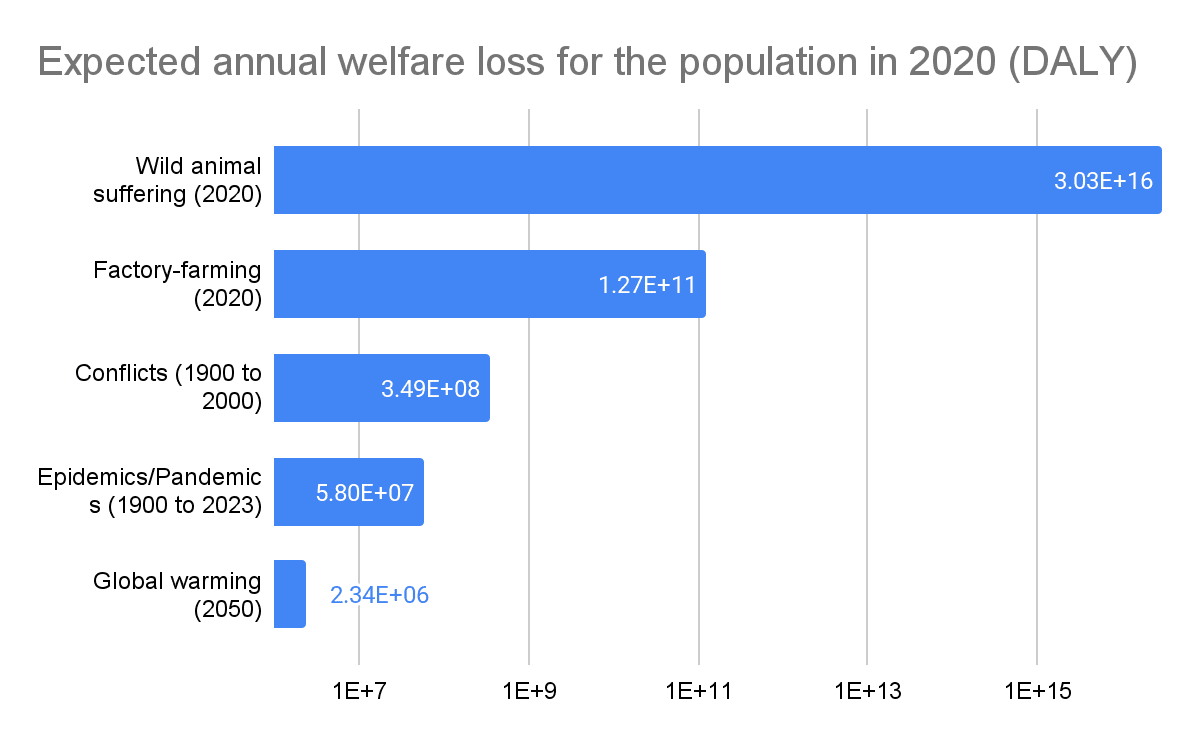
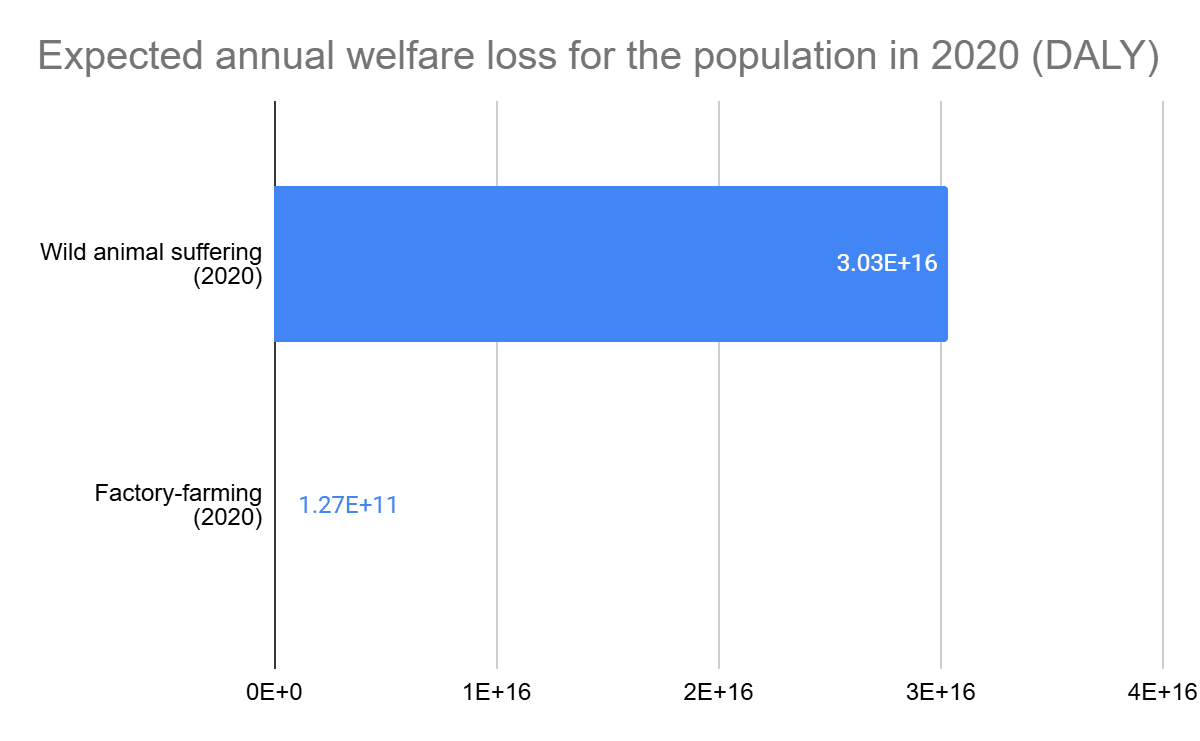
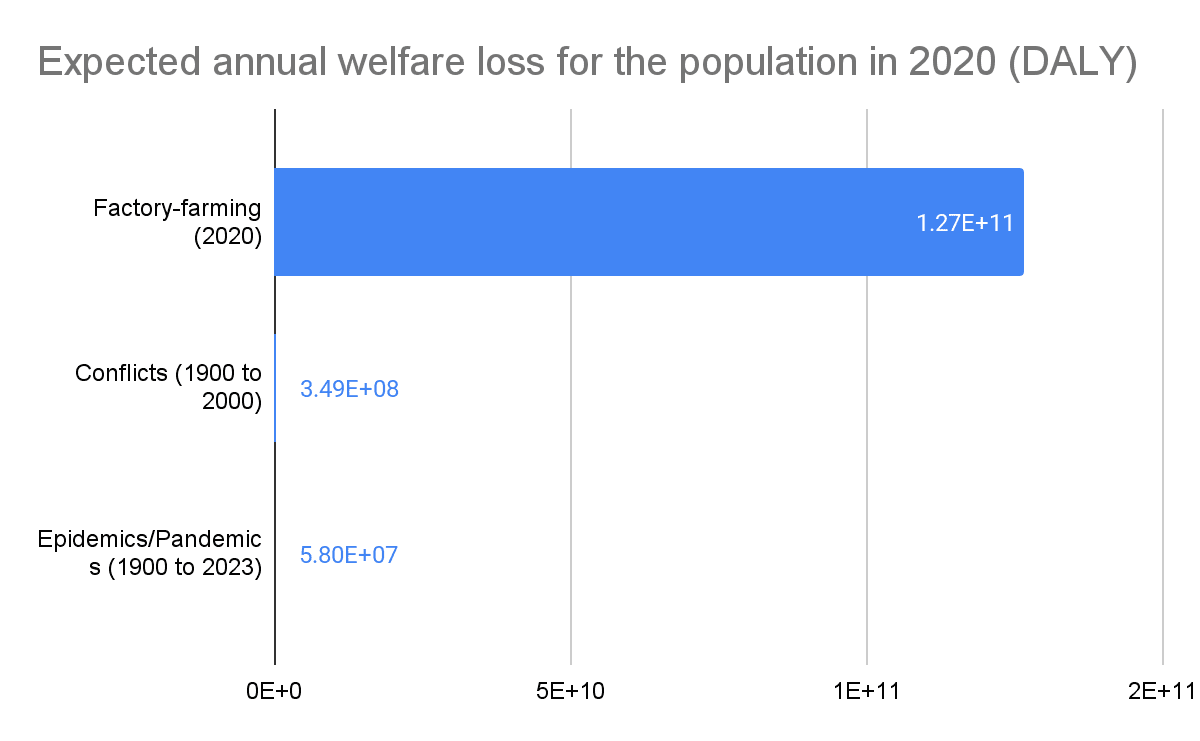
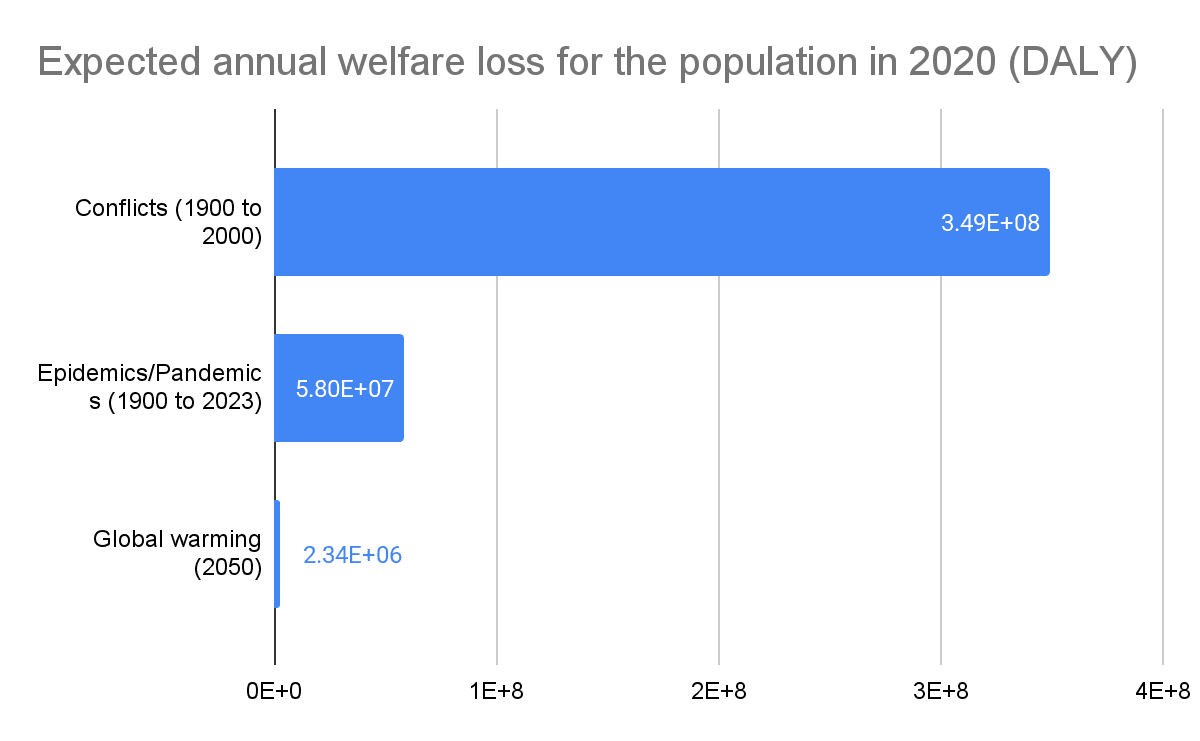
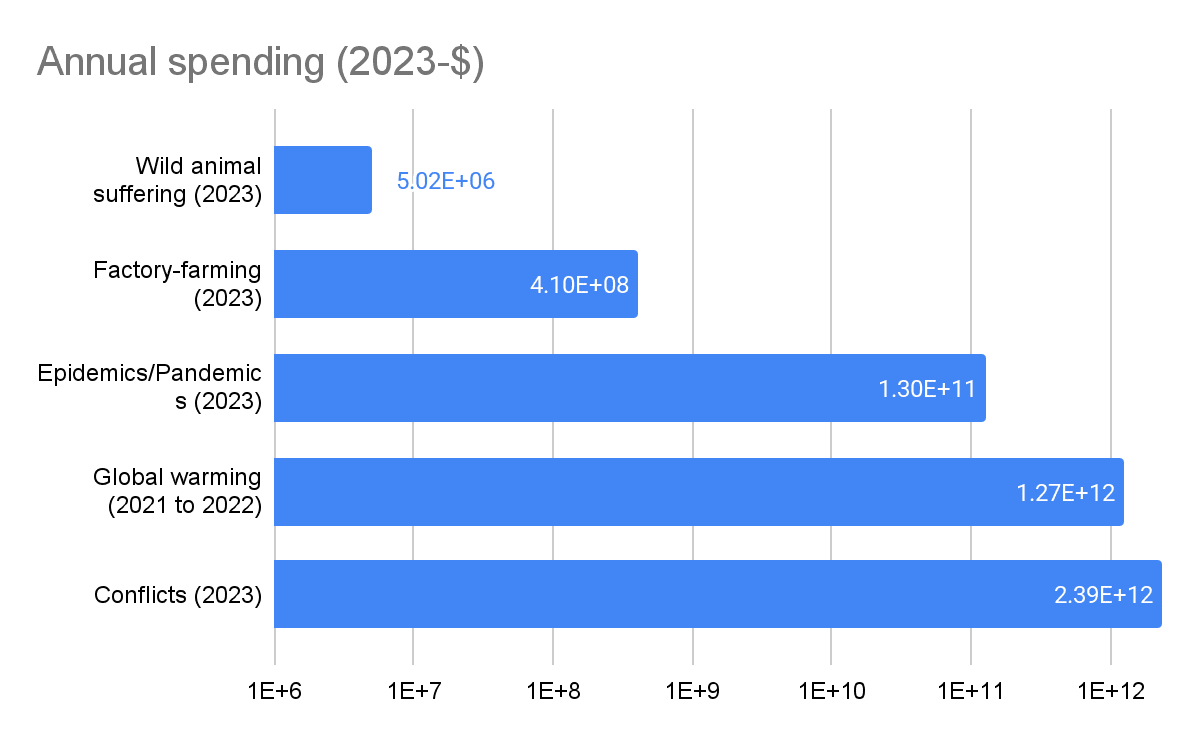
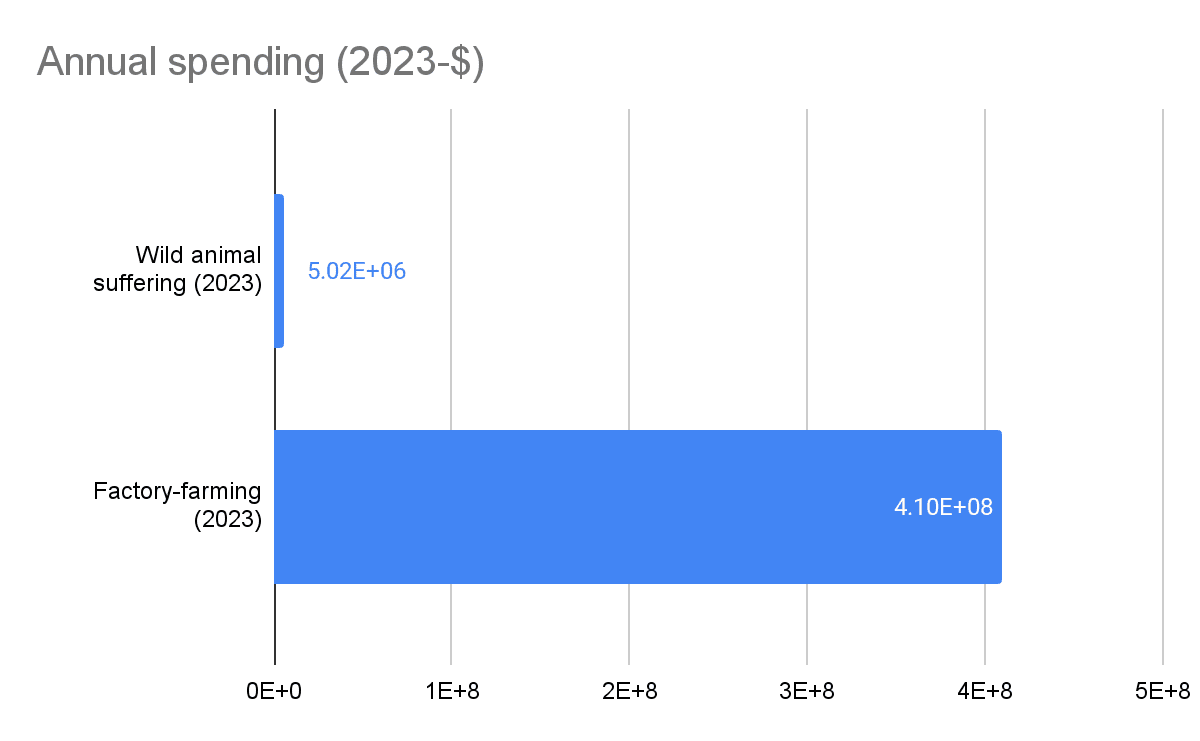
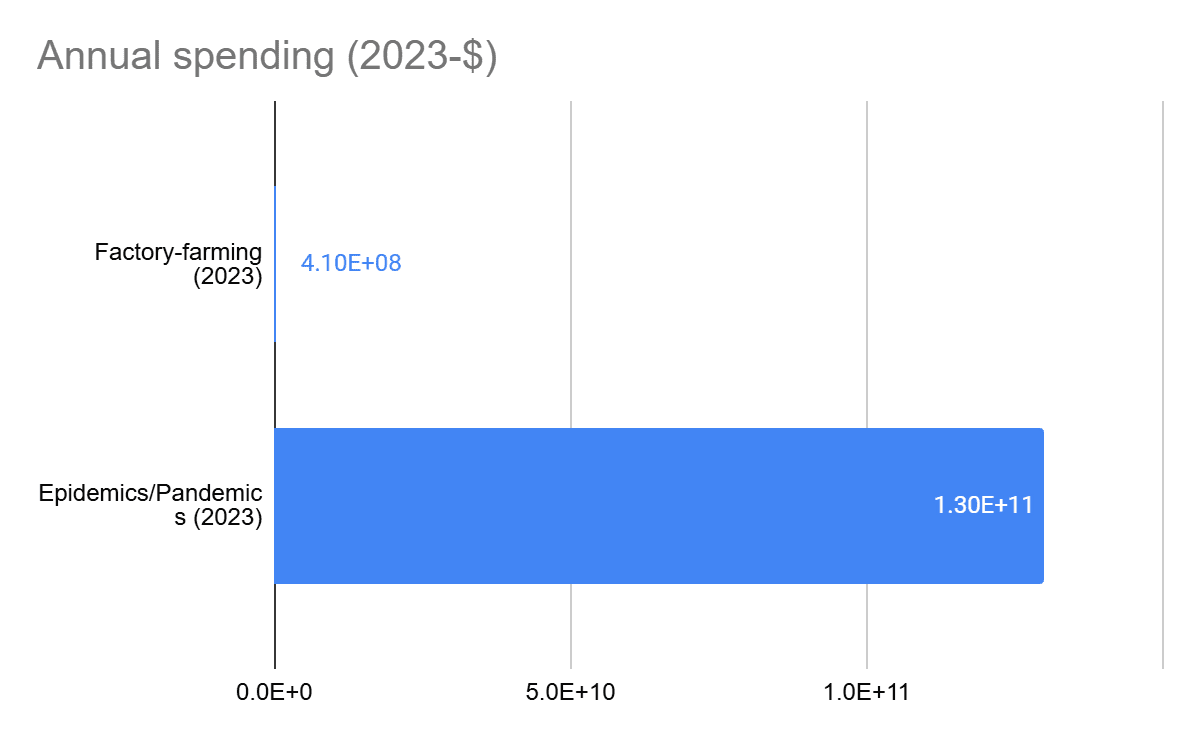
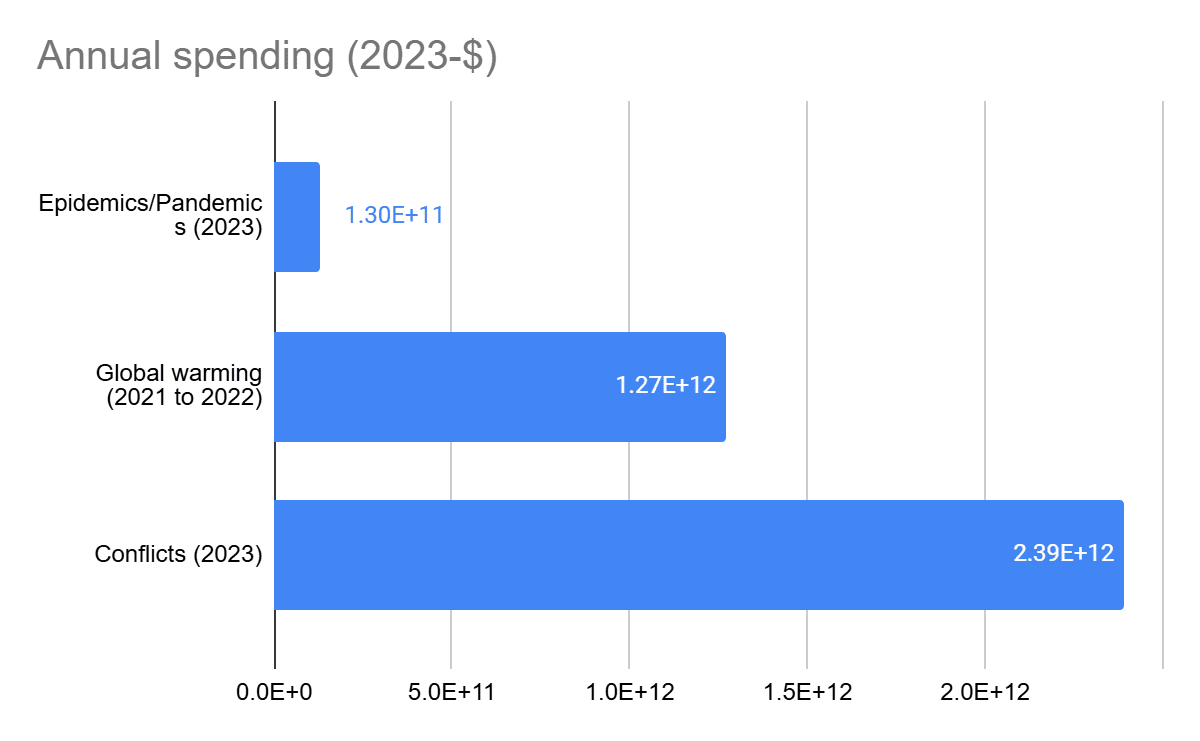

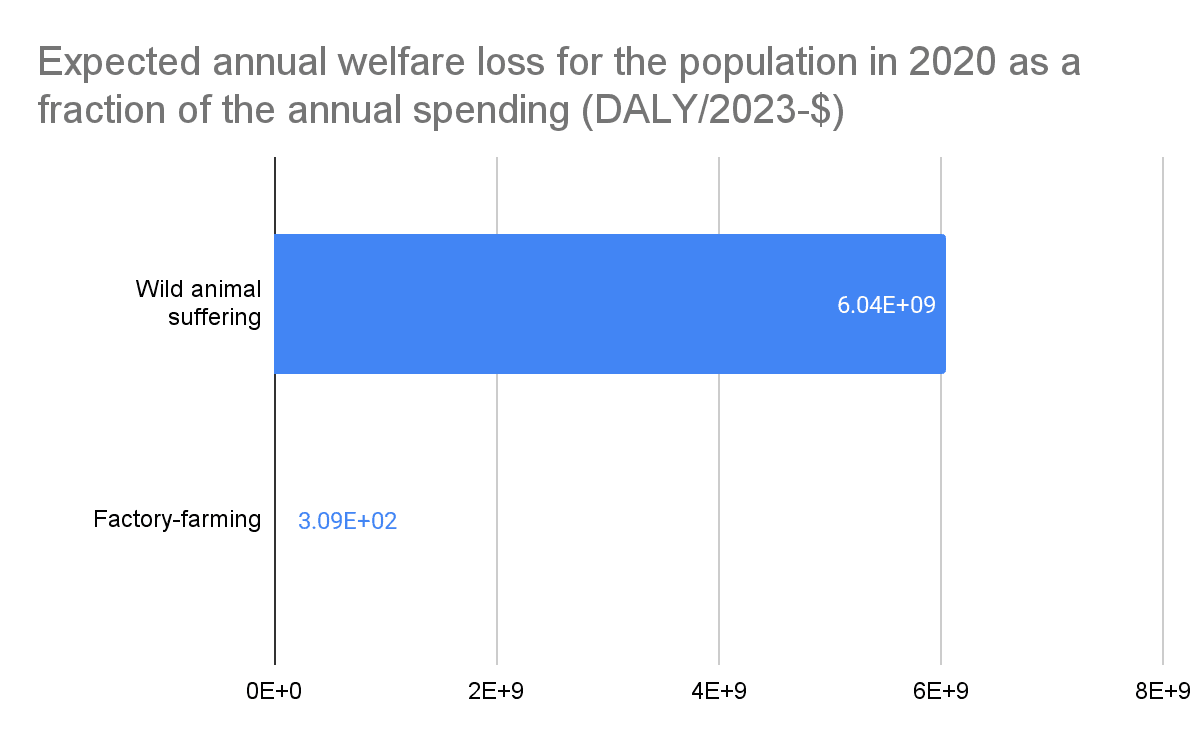
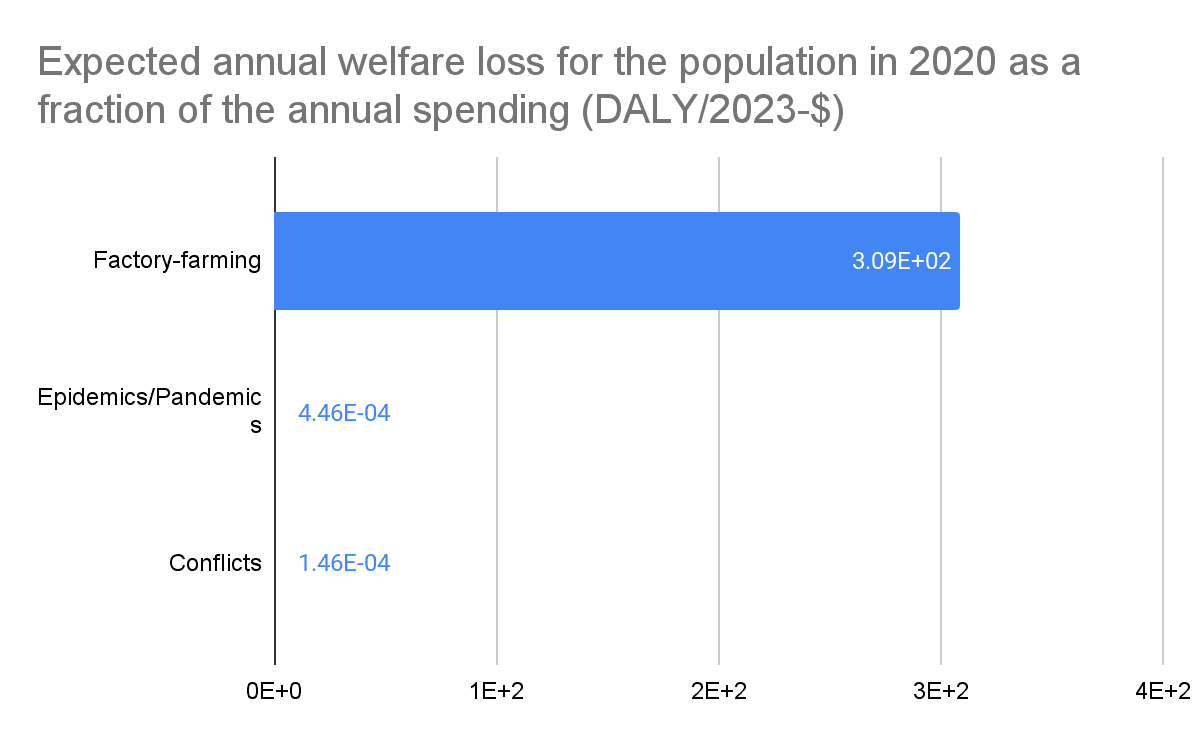
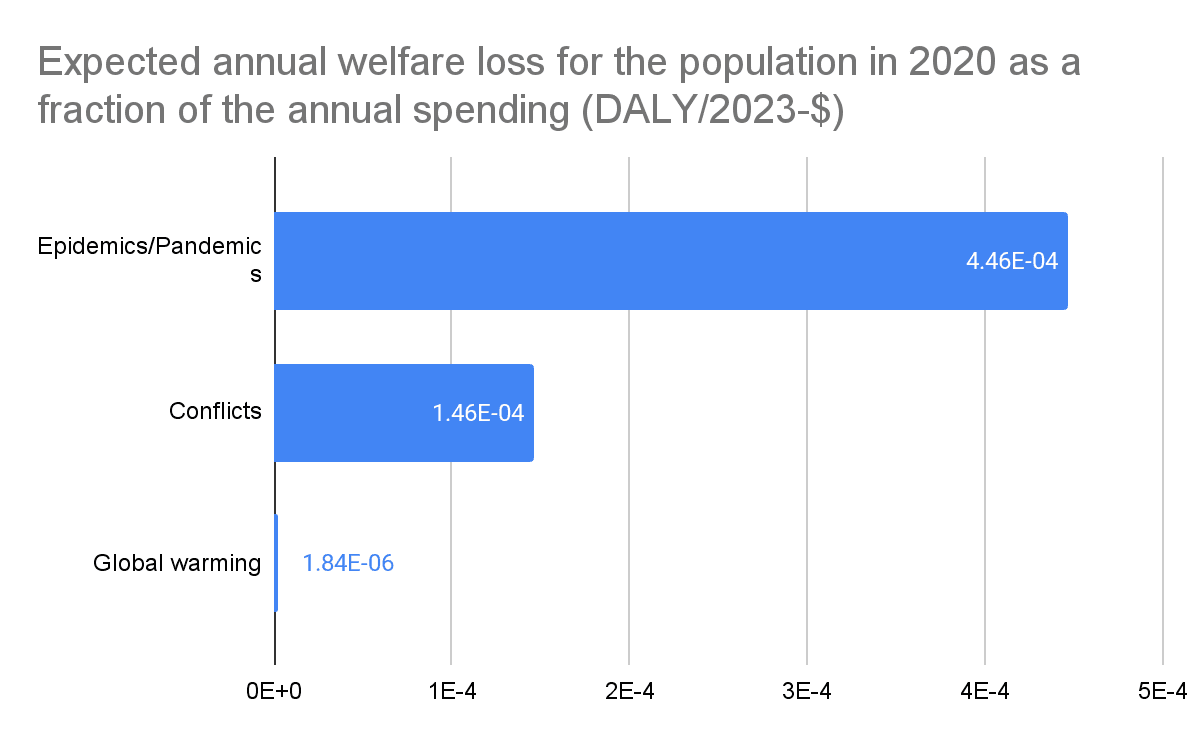
Heya Vasco, I think I might be missing something here. I’m struggling to see the connection between this post and your recommendation to donate to WAI.
In the past, I’ve heard that wild animal suffering is probably not very tractable. Is that true for both insects and vertebrates? What about WAI sets them up for success here? (You mention they support research into pesticides, but not direct work?)
Thanks, Huw.
Cost-effectiveness takes into account tractability, research on more humane pesticides looks super cost-effective, and WAI has supported work on that, although I do not know which fraction of the marginal donations to WAI funds that work.
... (read more)